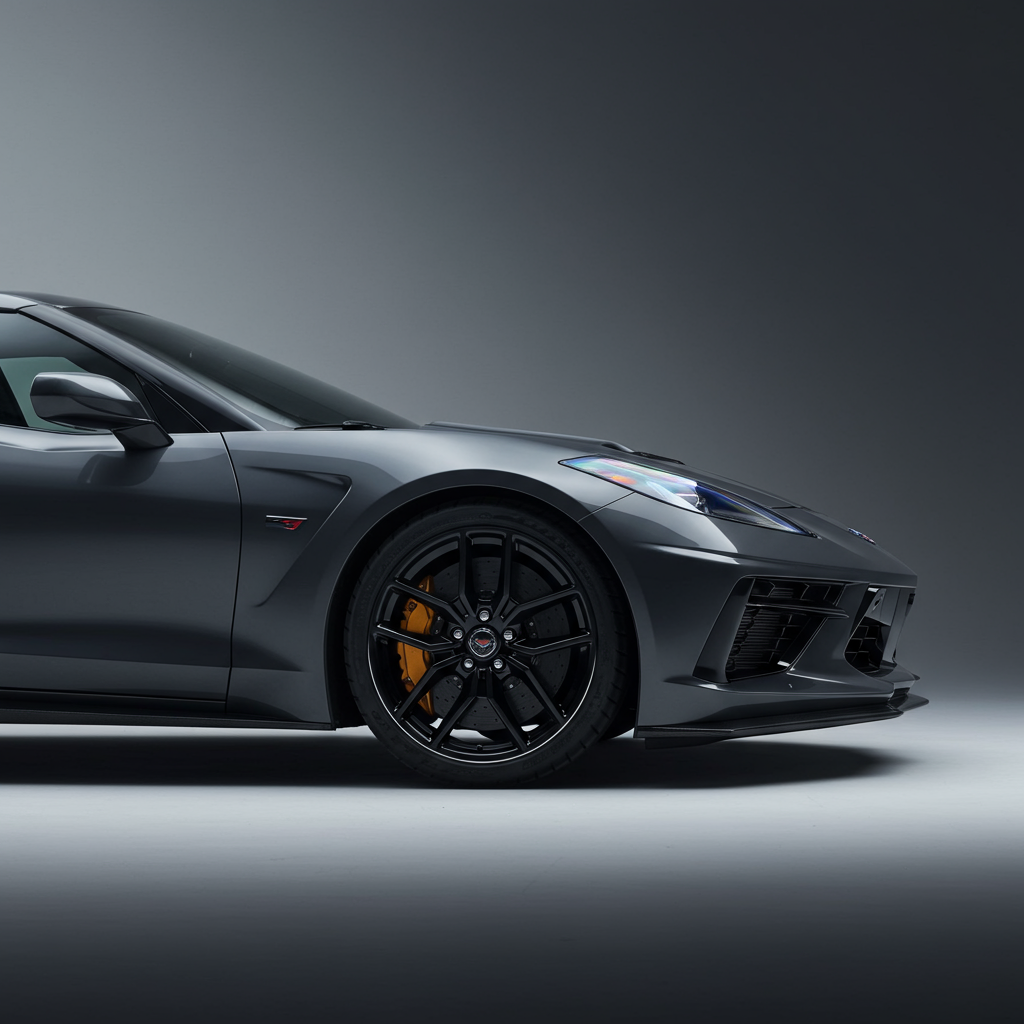Get ready for a new level of “patently absurd.” Chevrolet is dialing the performance of the already incredible C8 Corvette ZR1 up to 11 with the reveal of the 2026 Chevrolet Corvette ZR1X. This isn’t just a power bump; it’s an electrification jolt that transforms America’s sports car icon into a true hybrid hypercar designed to challenge the world’s elite.
While the standard 2025 Corvette ZR1, with its ferocious twin-turbo 5.5-liter V-8 producing 1,064 horsepower, already earned the moniker “America’s hypercar” and aimed its sights at European heavyweights like the McLaren 765LT, Lamborghini Revuelto, Ferrari SF90, and potentially the Porsche 911 GT2 RS, the ZR1X takes that ambition even further by adding hybrid power.
Hybrid Might: 1,250 HP and eAWD
The heart of the ZR1X’s upgrade lies in its sophisticated hybrid powertrain. It couples the ZR1’s monstrous LT7 twin-turbo V8, sending 1,064 hp and 826 lb-ft (or 828 lb-ft depending on source) to the rear wheels via an 8-speed dual-clutch transmission, with a potent electric motor mounted on the front axle.
This front electric motor, derived from the Corvette E-Ray but significantly upgraded, contributes an additional 186 horsepower and 145 lb-ft of torque. The combination results in a staggering total system output of 1,250 horsepower. This electrified front axle also gives the ZR1X all-wheel-drive capability, providing crucial off-the-line traction to manage the immense power.
The hybrid system uses a 1.9-kWh battery pack located low in the chassis. While the capacity is the same size as the E-Ray’s, Corvette engineers state they unlocked significantly more usable energy—around 26% more—with higher peak voltage, boosting the front motor’s output. The system is non-plug-in, relying on regenerative braking to recharge the battery, and is designed for rapid discharge and recharge cycles to provide performance boosts, not extended EV range. The front electric motor can provide power assist at speeds up to 160 mph.
Chevrolet highlights key engine tech on the LT7 V8, including its hand-built nature, a flat-plane crankshaft, finger-follower valvetrain, dry-sump lubrication, dual 76mm turbochargers, and a unique “maniturbo” exhaust design that places the turbos closer to the valves for enhanced throttle response. Dynamic anti-lag controls further improve responsiveness.
Record-Setting Acceleration
With 1,250 horsepower channeled through all four wheels, the 2026 Corvette ZR1X is poised to be the quickest production Corvette ever made. Chevrolet estimates jaw-dropping acceleration figures:
0-60 mph: Less than 2.0 seconds
Quarter Mile: Less than 9.0 seconds, exceeding 150 mph
If testing confirms these numbers, the ZR1X would not only be an “8-second factory car” but would also enter contention for the title of quickest production car tested, potentially challenging benchmarks like the Porsche Taycan Turbo GT Weissach (1.89 seconds). Simulations suggest the car can still achieve the standard ZR1’s estimated 233 mph top speed. Beyond straight-line speed, Chevy claims extraordinary G-force capabilities, including a peak longitudinal acceleration of 1.3g (maintained impressively through third gear) and the ability to pull 1g of both lateral and longitudinal acceleration simultaneously.
Advanced Chassis and Control
Managing 1,250 horsepower requires sophisticated control systems. The ZR1X features an enhanced eAWD chassis control system compared to the E-Ray, constantly monitoring vehicle conditions and driver inputs to seamlessly blend power delivery from the V8 and electric motor for optimal traction and predictable handling. Corvette engineers describe it as the “most approachable way” to achieve maximum capability, helping the car “claw you out” of corners.
Debuting on the 2026 Corvettes and central to the ZR1X’s track performance is the new Performance Traction Management (PTM) Pro system. This system allows drivers to turn off traditional stability and traction control for pure driving feel while retaining crucial active features. These include customizable Launch Control, Regen Brake Torque Vectoring for improved turn-in, and Front Axle Pre-Control which subtly varies front brake pressure to help dig for traction out of turns. Despite adding roughly 260 pounds (estimated curb weight around 4,200 lbs), retuned underbody aerodynamics help maintain chassis balance.
Unrivaled Stopping Power
To complement its blistering acceleration, the ZR1X comes standard with the “J59” braking package, a new-from-the-ground-up Alcon carbon-ceramic setup. This system features massive 16.5-inch rotors both front and rear – the largest diameter ever offered on a Corvette. Stopping power is provided by 10-piston calipers at the front (a first for GM production cars) and 6-piston calipers at the rear. Chevrolet highlights enhanced carbon fiber weave in the rotors for better heat management and claims this is their most resilient production car braking system tested, achieving impressive 1.9g deceleration rates from 180 mph down to 120 mph in testing.
Track-Focused Strategies and Aero
For drivers looking to maximize performance on the circuit, the ZR1X offers selectable energy deployment strategies for the hybrid system:
Endurance: Optimized for extended lapping, featuring a “Charge+” button to rapidly recharge the battery and maintain consistent eAWD output.
Qualifying: Provides the optimum power strategy for achieving the quickest single lap time.
Push-to-Pass: Delivers maximum available power on demand for quick bursts of acceleration.
The ZR1X includes magnetic suspension dampers and is available with bespoke Michelin Pilot Sport 4S or stickier Pilot Sport Cup 2R tires (with the ZTK package). The optional Carbon Aero package (standard on ZTK models) adds aggressive aerodynamic elements like dive planes, underbody strakes, a hood gurney lip, and a substantial rear wing, contributing to a claimed 1,200 lbs of downforce at top speed.
Refined 2026 Interior
As a 2026 model, the ZR1X benefits from the standard interior updates across the Corvette lineup. This includes a redesigned console with an improved drive-mode controller, tactile HVAC controls below the main display, and a new three-screen layout. The driver faces enlarged screens, including a 6.6-inch auxiliary display, while a new passenger grab handle replaces some previous switches. A built-in Performance App provides real-time vehicle data, complemented by new color options and higher-quality materials throughout.
Pricing and Availability
While Chevrolet did not announce official pricing for the 2026 Corvette ZR1X during its reveal, estimates place the starting price between roughly $190,000 and $210,000, a premium over the standard ZR1’s ~$175,000-$178,000 starting price. Customer deliveries are expected to begin in the fourth quarter of 2025. The ZR1X, like all Corvettes, will be built at GM’s Bowling Green Assembly Plant in Kentucky, with the LT7 V8 engines hand-assembled there. Both coupe and hardtop convertible body styles will be available. Given the unprecedented performance and anticipated demand, potential buyer concerns about dealer markups are likely.
The Name That Wasn’t “Zora”
One lingering question surrounding the new halo Corvette was whether it would finally adopt the long-speculated “Zora” name, honoring Corvette godfather Zora Arkus-Duntov. Despite GM registering trademarks for the name multiple times, Chevrolet elected to call this electrified beast the ZR1X. Executives explained this designation signifies an evolution of the ZR1 family. This decision suggests Chevrolet is either holding the Zora name for an even more* significant future model, or perhaps may never use it. Regardless of the moniker, as GM Senior VP Ken Morris noted, the C8 mid-engine architecture was designed “from day one” with this level of high-performance, hybridized variant in mind, fulfilling a long-term plan. The use of “X” also echoes the one-off C6 Z06x track concept from 2010.
The 2026 Chevrolet Corvette ZR1X represents the pinnacle of the eighth-generation Corvette platform. Combining the power of a twin-turbo V8 with the instant torque and all-wheel-drive traction of electrification, it delivers a level of performance previously unimaginable for America’s sports car, cementing its place as a legitimate contender in the global hypercar arena.




